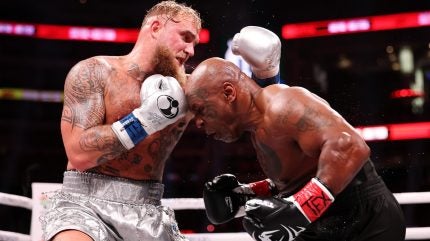
On Saturday night, millions of people around the world turned to Netflix to watch Jake Paul fight Mike Tyson.
Whatever your feelings on a 27-year-old man fighting a 58-year-old former boxing great with a questionable past and being paid tens of millions of dollars to do so, the fight attracted significant hype and global interest and allowed Netflix to show the world that not only could you stream your favourite shows, you could watch a sporting cultural moment live across a streaming service. Sadly, Netflix failed its audition.
The broadcast was beset by problems, with many taking to social media to complain about buffering issues impacting the overall presentation of what was supposed to be a sporting ‘moment’. Many predicted the fight would be a hard watch, but not due to technical issues.
While Netflix has successfully streamed live events in the past, such as a Nadal vs Alcaraz match and an F1/golf crossover event, neither of these would have commanded the kind of attention the Paul/Tyson event generated, hence the lack of issues.
Sports fans can argue over format, music, presentation style and the hosts. What they will not tolerate is a poor experience accessing the content, and it is here Netflix fell spectacularly short. When rival broadcasters gleefully point out your issues, then you know you are having a bad night.
Jerry Jones saying Netflix is a huge part of the NFL’s future into a mic that doesn’t work and then less than a minute later the stream goes down.
— Michael Mulvihill (@mulvihill79) November 16, 2024
What is noteworthy is that Netflix has a finite window in which to fix its latency issues before it becomes a sports rights holder proper.
Netflix has won the streaming rights to broadcast the NFL Christmas Day games, with Patrick Mahomes and Lamar Jackson hoping to bring some festive joy into the homes of fans as the Kansas City Chiefs take on the Pittsburgh Steelers and the Baltimore Ravens play the Houston Texans.
These games are likely to attract significant interest and the NFL is banking on the likes of Netflix taking on a far more prominent role in the sports broadcasting landscape.
If the NFL is planning to expand its global presence into new markets and territories, having a partner in Netflix which has over 280 million subscribers in more than 190 countries would be a good start.
Netflix has shown a willingness to get involved in ‘sport adjacent’ programming with its ‘Drive to Survive’ F1 series, however, its attempts to replicate this for tennis and cycling haven’t been as successful.
Netflix’s major statement of intent has been agreeing to show WWE programming, with the streaming giant taking all content for all markets outside of the US (its iconic RAW show will be on Netflix in the US) in a $5bn deal. WWE will also have been watching the Paul-Tyson stream with concern, given its live events such as Wrestlemania also have huge audiences.
WWE has been running its own network for a long time, so will be hoping that it can share some of its learnings with Netflix as the streaming platform takes over distribution and programming heading into its peak TV season.
Of course, other streaming services have seemingly cracked the code, so Netflix must be confident that it too can sort its delivery issues. Amazon Prime has been showing NFL games, Premier League matches in the UK and is now a Champions League broadcaster.
Apple has moved into sports with MLB and MLS rights in the US while DAZN has established itself in numerous markets around the world, showing a variety of sports from soccer to F1.
However, all have suffered from teething problems. Time lag is the biggest issue, and ensuring a seamless experience for all viewers is still a challenge experienced by all streaming platforms.
For the NFL, as alluded to by Dallas Cowboys owner Jerry Jones, Netflix represents a huge opportunity for the league to reach a much younger audience and grow the product.
For Netflix, sports rights guarantee an audience at a certain time, allowing it to finally move into a traditional advertising model which is the only way it can become profitable and debt-free.
Sports is still ‘must-see TV’ and as the Paul-Tyson fight proved, audiences love a spectacle. The challenge for Netflix and other streaming services is to ensure people can actually see it.



